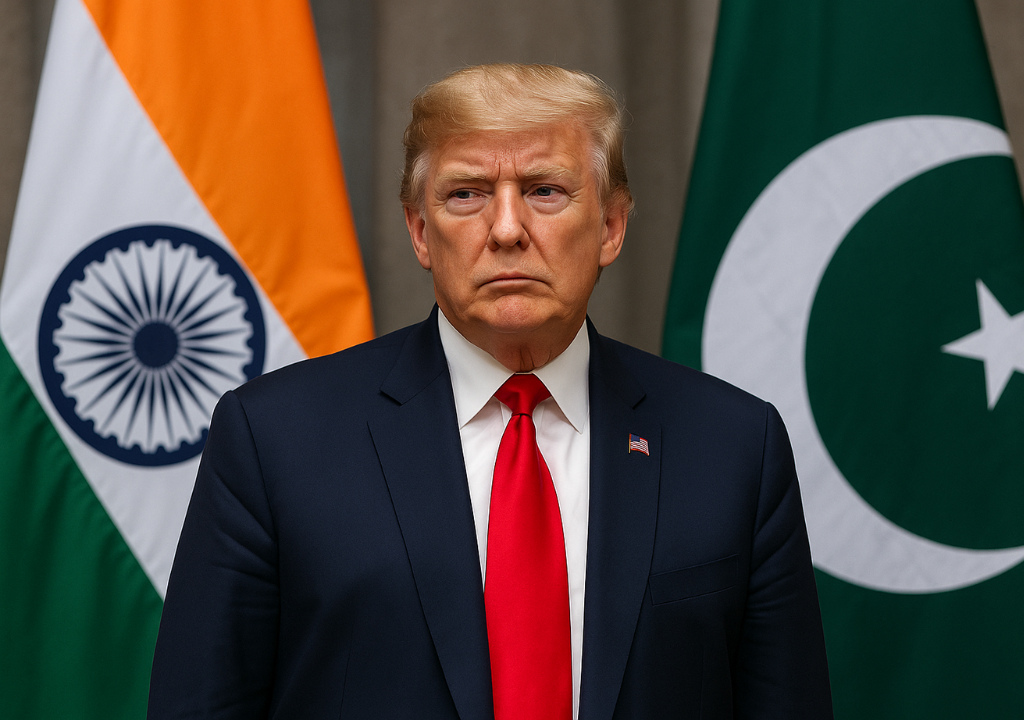In the aftermath of the fragile India-Pakistan ceasefire agreement, former US President Donald Trump made a bold trade promise, offering to significantly increase trade with both nations. The ceasefire, which followed days of deadly military exchanges along the Line of Control (LoC) and in Kashmir, brought temporary relief, but tensions remain high as violations of the agreement emerged almost immediately.
Trump’s Trade Promise: A Shift in US Diplomacy?
In a post on Truth Social, Trump expressed his admiration for the leaders of both India and Pakistan, stating:
“It was time to stop the current aggression, and I’m going to increase trade, substantially, with both of these great nations.”
This statement represents a notable shift in US diplomatic strategy, focusing not only on de-escalating tensions but also on fostering economic ties between the two nuclear-powered neighbors. Trump’s promise of increased trade was made despite the fact that the topic had not been discussed during the ceasefire negotiations.
Trump also went a step further, offering his assistance in finding a long-term solution for the Kashmir conflict, saying:
“I will work with New Delhi and Islamabad to see if, after a ‘thousand years,’ a solution can be arrived at concerning Kashmir.”

Ceasefire Agreement: Fragile Peace Amid Violations
The ceasefire agreement was reached late on May 10, following the high-level discussions between the Directors General of Military Operations (DGMO) of India and Pakistan. However, the peace was short-lived, as artillery fire was witnessed in Kashmir just hours after the agreement, and drone and missile strikes targeted civilian areas in India.
India Responds to Violations
India’s Foreign Secretary Vikram Misri condemned the violations:
“Over the last few hours, there have been repeated violations of the understanding arrived at earlier this evening between the Directors General of Military Operations of India and Pakistan. This is a breach of the understanding arrived at earlier today. The armed forces are giving an adequate and appropriate response to these violations.”
By dawn, the fighting had died down, but tensions remain high along the border. India has maintained that it is committed to defending its sovereignty and will uphold the ceasefire while remaining vigilant against further violations.
📌 Related Reading: UNSC Grills Pakistan Over Pahalgam Attack, Demands Accountability
India-Pakistan Tensions: A Context of Violence
The ceasefire followed intense military exchanges sparked by a deadly terror attack in Pahalgam, Jammu and Kashmir, on April 22. The attack, which killed 26 people, primarily Hindu tourists, was attributed to a Pakistan-based terror group, Jaish-e-Mohammed.
In response, India launched Operation Sindoor on May 7, targeting terror infrastructure in Pakistan and Pakistan-Occupied Kashmir (PoK). India’s airstrikes were specifically aimed at terrorist outfits rather than military or civilian targets.
Pakistan retaliated with heavy shelling along the LoC, which resulted in civilian deaths. Drone and missile strikes followed, targeting both civilian and military areas. Despite intercepting several of the incoming projectiles, India responded by striking Pakistan’s military installations, including key airbases.
Military Stance on Ceasefire: Vigilance and Preparedness
Following the ceasefire agreement, representatives from the Indian Army, Navy, and Air Force addressed a briefing, confirming that while India is committed to adhering to the ceasefire, it remains fully prepared for any future violations.
“We remain fully prepared and ever-vigilant. We are committed to defending the sovereignty and integrity of the motherland,” said an IAF representative.
This statement underscores the cautious optimism with which India is approaching the ceasefire, aware of the ongoing violations and the volatile nature of India-Pakistan relations.
🔗 Also Read: Indian Fighter Jets Bomb Pakistan Air Bases »
Pakistan’s Role in the Ceasefire Agreement
By the afternoon of May 10, Pakistan’s DGMO Major General Kashif Abdullah called his Indian counterpart, Lieutenant General Rajiv Ghai, to finalize the ceasefire agreement. The direct communication between the two military leaders was a crucial step toward stabilizing the situation, even as the Indian armed forces continue to maintain a high level of readiness.
What’s Next for India-Pakistan Relations?
While the India-Pakistan ceasefire offers a glimmer of hope, analysts remain skeptical about its longevity. The volatile nature of cross-border tensions, combined with Pakistan’s history of supporting terrorism, leaves little room for a long-lasting peace agreement without substantial changes on both sides.
Trump’s trade promise and mediation offer could play a significant role in shaping future India-Pakistan relations. However, the long-term success of any diplomatic efforts will depend on Pakistan’s commitment to dismantling terror infrastructure and India’s willingness to engage in peace talks.
Conclusion: A Fragile Ceasefire and Uncertain Future
The ceasefire agreement between India and Pakistan, though significant, remains fragile. As the situation unfolds, the Indian Air Force’s operations in Operation Sindoor have effectively dealt a blow to Pakistan’s terror infrastructure, sending a strong message of deterrence.
However, the violation of the ceasefire by Pakistan highlights that lasting peace remains fragile. With tensions still simmering beneath the surface, it is unclear whether this ceasefire will hold or whether the countries will once again descend into a cycle of violence.

